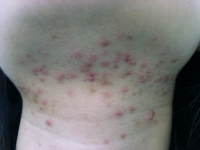Folliculitis
Folliculitis is an inflammation of the hair follicles usually caused by an infection with bacteria, although it can be due to chemical irritation (e.g. after-shaves) or by physical irritation (e.g. shaving, waxing). Typical body sites that are involved in folliculitis include the face, scalp and legs.
Folliculitis can affect anyone, at any age, but is more common in people who have diabetes mellitus or have compromised immune systems.
Other factors that may contribute to folliculitis include chronic skin diseases such as atopic eczema, tight occlusive clothing, sweating with hot and humid environment, and carriage of staphlococcus in the nasal passages.
Signs
Superficial folliculitis appears as a red and swollen pimple, with or without pus seen, either as a single one or in a cluster of multiples, around hair follicles. Pus-filled blisters may break open and crust over. It is painful and itchy.

Deep folliculitis starts deeper and affects the entire hair follicle. It appears as a large swollen bump and usually filled with pus. It can cause scarring, keloid formation and hair loss.
|
|
|
The regional lymph nodes may be enlarged and become painful.
Management & Treatments
Superficial folliculitis often clears by itself in a few days, but deep or recurring folliculitis may need medical treatment. Topical antiseptics such as triclosan, clorhexidine or povidone-iodine may be used to treat and prevent superficial folliculitis
For deeper folliculitis, topical or oral antibiotics are usually required. Steps are also needed to prevent damages and irritations such as avoid shaving in the affected area. If shaving is necessary, use a clean new razor blade each time. Washing the skin with an antibacterial soap may keep down the recurences.
Boils
A boil, also referred to as a skin abscess, is a localised infection deep in the skin, and it spreads away further from the site of onset.
It may start from a deep folliculitis, but any break in the skin, such as a cut or scrape, can develop into a boil if it is infected with bacteria.
Signs
It starts as a red, painful nodule, and as it spreads, it becomes firm and hard. The center then softens and fills with debris containing a large amount of pus, which may discharge spontaneously and heal with or without scarring, depending on the depth of infection. The nearby lymph nodes are almost invariably enlarged and painful.
A collection of boils is called a carbuncle, and in this case, the person can be unwell with a fever. This usually happens in a dense hair area such as the back of the scalp.
Management & Treatments
If a boil is soft and pointing, it can be drained of pus. Heat application will help to draw the pus more to the surface and make the draining easier. Antibiotics are often necessary to eliminate the bacterial infection in addition to drainage.
If recurrent boils are seen, then it may be necessary to investigate the possibility of underlying problems such as diabetes mellitus, or carriage of staphylococcus in the nasal passages.



